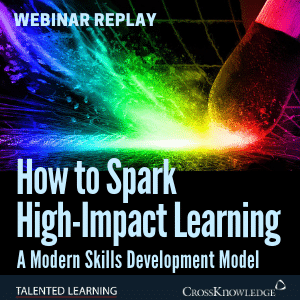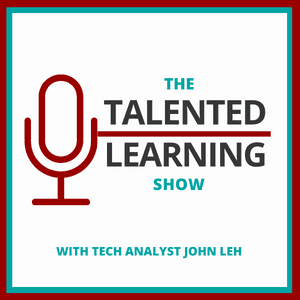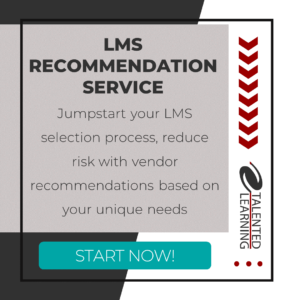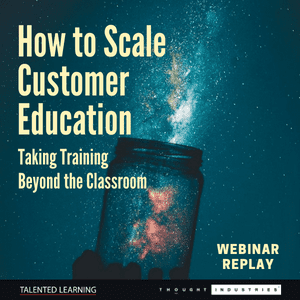
Podcast: Play in new window | Download
Subscribe: Apple Podcasts | Spotify | Amazon Music | Android | iHeartRadio | Blubrry | Email | RSS
WELCOME TO EPISODE 20 OF THE TALENTED LEARNING SHOW!
To learn more about this podcast series or to see the full collection of episodes visit The Talented Learning Show main page.
EPISODE 20 – TOPIC SUMMARY AND GUEST:
If you follow our blog, you know I’m fascinated with elearning trends. It’s not because I’m obsessed with chasing every new “shiny penny” innovation that rolls by. But as an analyst, I need and want to understand everything that drives the business of learning.
So naturally, I jump at the chance to compare notes with industry experts like Donald H. Taylor whenever I’m able.
Don is one of the best-known voices in the global learning community. He’s a 30-year veteran with experience at every level, from training design and delivery to executive positions at software companies. Since 2010, he has served as chairman of the Learning and Performance Institute. And since 2000, he has chaired the Learning Technologies Conference.
Today, we’re fortunate to talk with Don about the results of his annual L&D Global Sentiment Survey – a must-read for anyone who cares about the direction of learning technologies!
KEY TAKEAWAYS:
- In recent years, elearning trends have shifted significantly. However, global opinions aren’t homogeneous and trends differ geographically for multiple reasons.
- Extended enterprise learning hasn’t yet appeared on the global L&D “hot” list. But this could be a competitive advantage for companies that embrace customer and channel education.
- For many more findings from Don’s annual L&D pulse survey, tune-in to the full podcast. As a bonus, he also shares career advice for future-minded learning professionals.
Q&A HIGHLIGHTS:
Although you’re based in the U.K., you have a strong global perspective on corporate learning and development. What similarities and differences do you see, geographically?
It’s certainly not the same everywhere, but the differences are not necessarily predictable. There’s a phrase, “If the U.S.A. sneezes, the rest of the world catches a cold.” In other words, sometimes when we see developments on your side of the Atlantic, there’s a ripple effect around the world.
How have you seen that apply to learning technologies?
Microlearning is a great example. The huge surge of U.S. interest in 2015 and 2016 came over to the rest of the world in 2017 and 2018. But it’s not always like that.
Sometimes things get really interesting elsewhere in the world, and the U.S. picks up on it. And then, of course, there are isolated things that are uniquely different everywhere in the world.
How so?
For some reason, the U.S. is particularly interested in personalization. But in India, for example, that’s a much lower priority, while learning analytics is far higher. And of course, there are differences in how people approach learning, which I think is affected by their environment. This also affects their technology interests.
For example?
Recently, I asked a New Zealander what makes learning in that country different. She came straight back and said, “Well, we do things with number 8 wire.”
In New Zealand, number 8 wire is a particular gauge of wire that farmers use to fix everything. It’s a bit like WD-40 or duct tape.
So she was saying that, because New Zealand is a sparsely populated country, learning departments are small and they tend to do everything themselves. That’s not like multinational organizations you find in the U.S., the U.K. and Europe. In these countries you’ll find many companies with vast L&D departments and much more specialization.
It’s interesting that you see so many variations…
It’s not the same everywhere. And we should celebrate that fact.
So let’s drill down on your Global L&D Sentiment Survey – your annual one-question poll that reveals so much about the expectations of learning professionals around the world. What’s your goal?
The idea here is to check the pulse of the learning community. Just quickly ask, “Hey, what’s on your mind as you look ahead to the next year?” That’s it.
It’s not what they’re planning. It’s not about what’s in their budget. We’re just looking for a gut reaction.
I see…
To answer, they can choose one, two or three of 16 options offered. Or they can choose “other” and write-in something if they want. But actually, fewer and fewer people are doing that each year.
Interesting!
And here’s another interesting thing. Because we reach out through social media and email, we get people who are right at the beginning of the adoption curve. So what ranks high in one year can become “business as usual” 2, 3 or 4 years down the line. That tells me this poll is a good leading indicator.
It’s good to see that the three most popular responses this year cluster around a single concept – the smart use of data.
It’s incredible, John, because it’s the first time we’ve ever had three answers at the top of the table that are so closely unified by a common theme.
The most popular response is personalization, which relies heavily on artificial intelligence. Second is AI, itself. And third is learning analytics, which also has a strong AI component. What do you make of that?
I think it shows that learning and development practitioners understand what’s happening in the world. We come across personalization all the time in our daily lives, as consumers on Netflix, on Amazon, on Google. We see it and understand that L&D can benefit from it.
Learning analytics is slightly different because I think we come across it less often in our lives as consumers. But at work, we bump up against what other disciplines are doing with analytics, so we understand that more or better information can be very powerful in improving decisions.
I see. So when and why did you decide to invest your time in this analysis? And what does the learning community think about it?
Well, as always, if you publish something that confirms someone’s suspicions or prejudices or ideas, immediately they leap on it and say, “Hey, look. This proved I’m right!”
Yep…
The reason why I do it is simple. It wasn’t already out there. I chair the Learning Technologies Conference in London and I’m also involved with programming for other industry events. So I need to have a handle on what people are thinking and talking about.
Plus I just love it. I love getting down into the data and trying to figure out what’s really going on.
You know, if one person says, “I think these three things will be hot next year.” Okay, great. That’s one person’s opinion. But when 2,000 people say it over 6 years, you start to see some trends. It’s really fascinating to dig into the input and make sense of it.
So, you added year-over-year trend analysis a few years ago. Is that when the survey really took on a life of its own?
Yeah, absolutely. As soon as you add longitudinal data and people start looking at where trends are going, it becomes much more interesting. Building up the body of data over time has really created value.
Makes sense…
For example, mobile delivery is dropping down the table. What does that mean? Well, it actually doesn’t mean that mobile delivery is less important. What it does mean is that people think it’s less “hot.”
In other words, it’s moving from something exciting to something that’s “business as usual.” So you have to add that bit of thinking around those year-on-year numbers to understand what’s really happening over time.
What else do you see moving down the list?
Well, sometimes moving down the list means people just don’t get it.
MOOCs, for example, went down the list pretty quickly. It’s not because people are using loads of MOOCs now. It’s because people couldn’t really get a handle on it and they moved on to something else. So there are different reasons why things move up and down the list.
Anything else losing steam because it just didn’t stick?
I hate to say it, but gamification.
Now, in many ways I’m a big fan of gamification, because I’ve seen it work. People have grabbed hold of the concept, but it hasn’t translated from concept to reality. People have found it difficult to really put it to work. As a result, it’s not as exciting as other things on the list.
You say that “other” answers are less frequent now. That’s interesting. I would assume that you receive many “other” responses and they shape your view. But that’s not the case?
Yes, over the years, we’ve seen fewer people as a percentage choosing to write-in an answer. It’s been a steady decline.
Perhaps I’m getting better at picking the winners. Or perhaps as my reach expands each year, those who don’t feel a personal connection with me may not feel comfortable suggesting additional ideas.
I don’t know the reason. I’ll need to take a closer look at why. But I kind of miss those “other” ideas. It’s always fun to read through those responses and pick-up on some of that stuff.
Well, because we focus on extended enterprise applications here at Talented Learning, I’m curious how much interest you see in that a topic?
It’s not a big topic right now. I’d say the U.S. leads in this because of its scale. It’s a huge country with one language and one currency. Large U.S. companies may be dealing with tens of thousands of customers, compared with thousands at large U.K. companies.
The need for U.S. companies to reach so many customers from a distance has led to a lot of innovation in the “e” space – elearning, ecommerce and so on. Then the rest of the world picks up on it.
From that perspective, extended enterprise learning can be a competitive advantage, so it’s worthwhile for U.S. companies to get it right. Maybe I should include extended enterprise learning on the list next year? We’ll see.
I think it would be good to add to the list. But I’m not biased at all…
It is actually being done outside the U.S. now. For example, hardware stores in the U.K. don’t want their sales staff tied-up describing how things work, so they try to make that information widely available for self-service customer learning.
But something with the kind of sophistication you describe isn’t yet “hot” in the rest of the world. It surged for a while in the 2000s and is just starting to come back now. It’s definitely one to watch and I’m looking forward to seeing it…
FOR MORE QUESTIONS AND COMPLETE ANSWERS, LISTEN TO THE FULL PODCAST NOW!
Want to Learn More? Replay this recent webinar:
Technology vs. Innovation: Association Learning Strategies in Practice
AI. AR. VR. Digital breakthroughs like these are capturing headlines every day. Clearly, these innovations are promising. But many associations are focused on making the most of learning technologies that are already in place.
So how are these resourceful organizations actually transforming member learning experiences?
Join John Leh, CEO and Lead Analyst at Talented Learning, and Michelle Brien, VP Marketing at WBT Systems, as they explore real-world examples and discuss innovation strategies that will help you create lasting value. You’ll discover:
- The push/pull relationship between technology and change
- How to develop an innovation roadmap that works for your organization
- Tips for creating a business case your board will support
- How to avoid missteps when expanding your learning technology stack
- Guidelines for measuring results
Need Proven LMS Selection Guidance?
Looking for a learning platform that truly fits your organization’s needs? We’re here to help! Submit the form below to schedule a free preliminary consultation at your convenience.
[gravityform id=”18″ title=”false” description=”false”]







